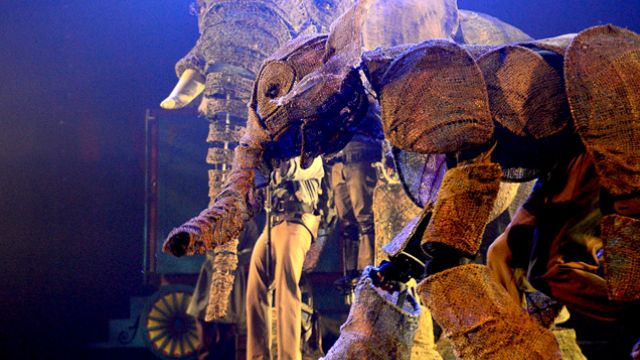Circus 1903
Modern circus productions, increasingly resting on an overarching narrative, have been an interesting innovation in indoor theatre, where the seats and atmosphere are usually more comfortable than a tent can provide. But there’s something to be said for the feel of old-circus, with its simple performances by a circus art’s most spectacular exponents; its unpredictability; the obvious hazards in performance height and the presence of carnivorous animals. (The danger of falling, though muted by falling mats, is real; in the show’s first two days, two acrobats took genuinely unplanned falls. The show’s carnivorous animals, though, may be more cute than dangerous.) And it was with the vision of re-creating this sense of old-time circus and its wonders that producer Simon Painter, producer of The Illusionists 1903, devised Circus 1903.
Having hired and unified talent from the farthest reaches of the globe, Circus 1903 looks set to repeat the phenomenon of The Illusionists 1903, still on three simultaneous tours throughout the world. The production’s appeal is very broad. On opening night, the ringmaster, Willy Whipsnade, a comedian with perfect timing, he evoked much laughter throughout; he even had the audience cackling before the show began. The production features two awesome “puppets” — made, it seems, of hessian, pistons, and electronics — which Significant Object (makers of the puppets for War Horse) has fashioned into loveable, larger-than-life elephants. The music, the variety of which composer Evan Jolly suited to the various acts, was catchy, even stirring. The costumes had an old-fashioned circus feel, no performer making the mistake of displaying obviously modern adornments. And the beautifully controlled spotlighting, which replicated the experience of the big ring, did its part in varying the emotional temperature.
 But of course the principal attraction of the circus lies in its extremities of skill and daring, without which the rest are mere trappings. And its acts were very well done. Several were simply spectacular. You have may seen many stunt cyclists, many jugglers, many acrobats perform before now, but the chances are good that you have never seen performers with such style and frank daring as The Cycling Cyclone, on the bicycle; The Great Gaston, on the juggling pins; the brothers Rossi, juggling each other; Les Incredibles, on “aerial ballet”; and The Flying Fins (including an Australian who joined the production, due to performer injury, a week before its first performance), on teeter board. I don’t recall ever seeing such heartstopping acrobatics; I know that I’ve never seen juggling so smooth or so mindbogglingly rapid.
But of course the principal attraction of the circus lies in its extremities of skill and daring, without which the rest are mere trappings. And its acts were very well done. Several were simply spectacular. You have may seen many stunt cyclists, many jugglers, many acrobats perform before now, but the chances are good that you have never seen performers with such style and frank daring as The Cycling Cyclone, on the bicycle; The Great Gaston, on the juggling pins; the brothers Rossi, juggling each other; Les Incredibles, on “aerial ballet”; and The Flying Fins (including an Australian who joined the production, due to performer injury, a week before its first performance), on teeter board. I don’t recall ever seeing such heartstopping acrobatics; I know that I’ve never seen juggling so smooth or so mindbogglingly rapid.
The show has a great deal to recommend it. Some audience members teared up at the beauty of Lucky Moon’s hoop performance; others couldn’t get over the evident risk to two aerial cyclists and a passenger. And every piece of superb magic produced sighs of appreciation.
Even the circus contortionist employed rare artistry in virtually dancing through impossible routines. Every act was classy; none disappointed; the surprises were legion. And, as circus should, it dazzled the children as much as it did the adults.
If you’ve forgotten what it was that made circus the romantic spectacle it once was, let Circus 1903 remind you.
John P. Harvey
David Spicer adds his thoughts.
The premiere in the Sydney Opera House was a combination of elegance, thrills and spills. It was an evening of competing jaw dropping acts.
The "sensational" Mikhail Sozonov (from Moscow) swivels on top of numerous steel clinders, in various curved shapes, with several moving in opposite directions. His 360 degree rotation was extraordinary.
The "Elastic Dislocationist" Senayet Assefa Amara (from Ethiopia) resembles a crab as she twists and turns her body in so many unsual ways that it makes your eyes water. Stretch any further and she might snap.
Alejandro and Ricardo Rossi (from Spain) dazzled with foot juggling. One of the brothers is lying down on what looks like a see saw, which he uses to catapault his sibling over and over. A slight miss saw one of the brothers in need of a breather after being winded.
Elegant cycle ballet, twirling knife and fire throwing, and the beauty of epic life size elephant puppets all added to the spectacle in a production that beautifully evoked a by-gone era.
Images: Elephants Queenie and Peanut, and The Flying Fins, in Circus 1903. Photographer: John P. Harvey.
Subscribe to our E-Newsletter, buy our latest print edition or find a Performing Arts book at Book Nook.

